The Sabrent ROCKET NVMe PCIe SSD is an end-user M.2 SSD that leverages the PCIe Gen3 x4 interface and 3D TLC NAND. Distinguished by the color of their branding, the black and blue Rocket is the mid-range line of Sabrent’s SSD portfolio. We also reviewed the high-end Sabrent Rocket PCIe 4.0 SSD back in July. Nonetheless, one of the more notable highlights of the Sabrent line is its generous range of capacities, which includes a 4TB model. The drive also supports SMART and TRIM commands and features Advanced Wear Leveling, Bad Block Management, and Over-Provisioning.
The Sabrent ROCKET NVMe PCIe SSD is an end-user M.2 SSD that leverages the PCIe Gen3 x4 interface and 3D TLC NAND. Distinguished by the color of their branding, the black and blue Rocket is the mid-range line of Sabrent’s SSD portfolio. We also reviewed the high-end Sabrent Rocket PCIe 4.0 SSD back in July. Nonetheless, one of the more notable highlights of the Sabrent line is its generous range of capacities, which includes a 4TB model. The drive also supports SMART and TRIM commands and features Advanced Wear Leveling, Bad Block Management, and Over-Provisioning.
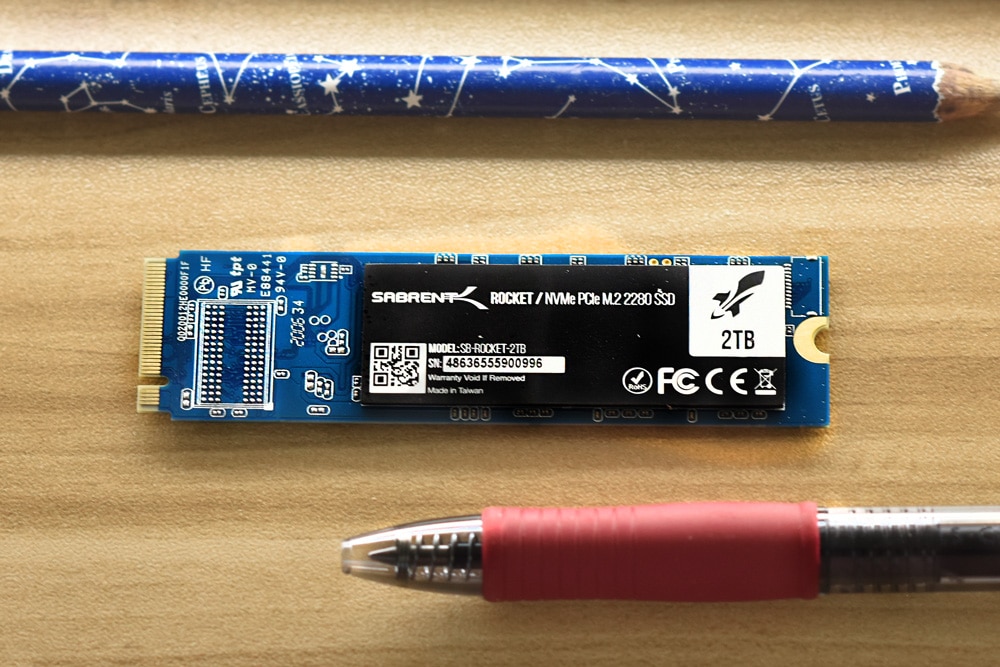 Like all consumer drives of this class, the Rocket targets users looking to upgrade their system to NVMe technology as well as those who simply need speedy supplemental storage to run their software or graphics-intensive games. Sabrent quotes the usual performance numbers we’ve come to expect with consumer NVMe SSDs, quoting up to 3,400 MB/s and 3,000MB/s in sequential reads and writes, while random performance is expected to hit up to 650,000 IOPS. The Sabrent Rocket also comes with some decent endurance numbers as well, including 1.8 million hours MTBF for all capacity models.
Like all consumer drives of this class, the Rocket targets users looking to upgrade their system to NVMe technology as well as those who simply need speedy supplemental storage to run their software or graphics-intensive games. Sabrent quotes the usual performance numbers we’ve come to expect with consumer NVMe SSDs, quoting up to 3,400 MB/s and 3,000MB/s in sequential reads and writes, while random performance is expected to hit up to 650,000 IOPS. The Sabrent Rocket also comes with some decent endurance numbers as well, including 1.8 million hours MTBF for all capacity models.
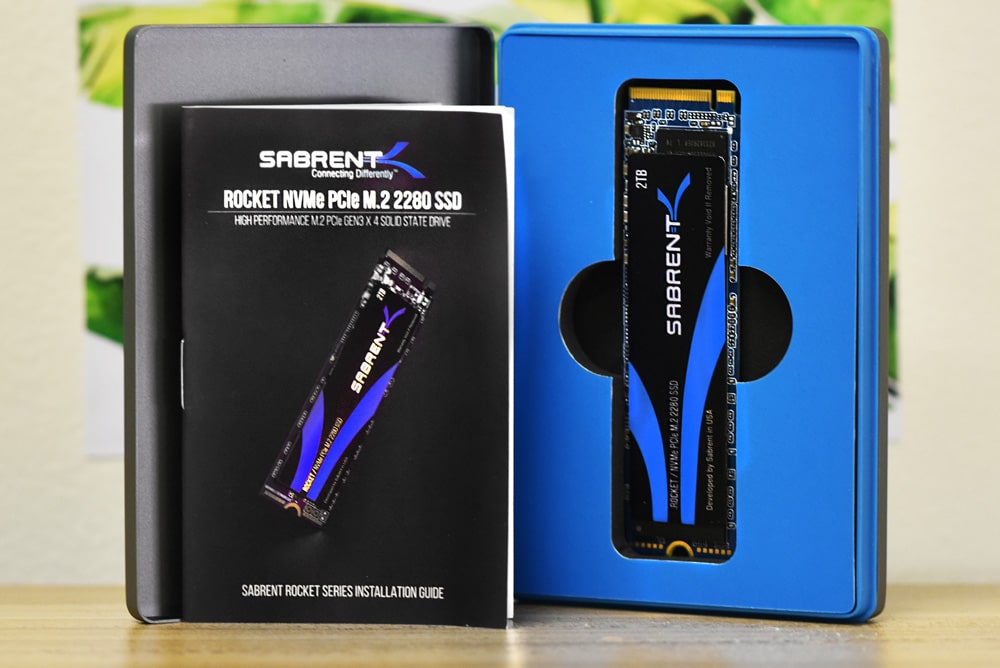
Backed by a 1-year warranty (5 years if you register the drive with Sabrent), the Rocket currently goes for roughly $50 (256GB), $80 (512GB), $150 (1TB), $280 (2TB), and $750 (4TB). We will be looking a the 2TB model for this review.
Sabrent Rocket NVMe PCIe SSD Specifications
| Drive Capacity | 256GB, 512GB, 1TB, 2TB, 4TB |
| Interface | PCIe 3.1 x4 |
| Maximum Read Speed | up to 3,400 MB/s |
| Maximum Write Speed | up to 3,000 MB/s |
| Random Read Speed | up to 650,000 IOPS |
| Random Write Speed | up to 650,000 IOPS |
| Drive Type | SSD |
| Form Factor | M.2 2280 |
| SMART Support | Yes |
| TRIM Support | Yes |
| Mean Time Between Failures (MTBF) | 1,800,000 Hours |
| Power Draw | 6.6 W 5.3 W |
| Supported Voltage | 3.3 VDC |
| Operating Shock | 1500 G |
| Operating Temperature | 32 to 158°F / 0 to 70°C |
| Storage Temperature | -40 to 185°F / -40 to 85°C |
| Certifications | BSMI, CE, FCC, RoHS, as per Manufacturer |
| Dimensions (W x H x D) | 0.87 x 0.15 x 3.15″ / 22 x 3.7 x 80 mm |
| Weight | 0.2 oz / 6 g |
| Warranty Length | Limited 1-Year Warranty (5 years with registration) |
| Package Weight | 0.12 lb |
| Box Dimensions (LxWxH) | 5.9 x 4.7 x 1.1″ |
Sabrent Rocket NVMe PCIe SSD Performance
Testbed
Our SSD reviews leverage a Lenovo ThinkSystem SR850 for application tests (Note: we had to use an adapter card instead of a front bay slot due to a compatibility issue) and a Dell PowerEdge R740xd for synthetic benchmarks. The ThinkSystem SR850 is a well-equipped quad-CPU platform, offering CPU power well in excess of what’s needed to stress high-performance local storage. Synthetic tests that don’t require a lot of CPU resources use the more traditional dual-processor server. In both cases, the intent is to showcase local storage in the best light possible that aligns with storage vendor maximum drive specs.
Lenovo ThinkSystem SR850
- 4 x Intel Platinum 8160 CPU (2.1GHz x 24 Cores)
- 16 x 32GB DDR4-2666Mhz ECC DRAM
- 2 x RAID 930-8i 12Gb/s RAID Cards
- 8 NVMe Bays
- VMware ESXI 6.5
Dell PowerEdge R740xd
- 2 x Intel Gold 6130 CPU (2.1GHz x 16 Cores)
- 4 x 16GB DDR4-2666MHz ECC DRAM
- 1x PERC 730 2GB 12Gb/s RAID Card
- Add-in NVMe Adapter
- Ubuntu-16.04.3-desktop-amd64
Houdini by SideFX
The Houdini test is specifically designed to evaluate storage performance as it relates to CGI rendering. The testbed for this application is a variant of the core Dell PowerEdge R740xd server type we use in the lab with dual Intel 6130 CPUs and 64GB DRAM. In this case, we installed Ubuntu Desktop (ubuntu-16.04.3-desktop-amd64) running bare metal. The output of the benchmark is measured in seconds to complete, with fewer being better.
The Maelstrom demo represents a section of the rendering pipeline that highlights the performance capabilities of storage by demonstrating its ability to effectively use the swap file as a form of extended memory. The test does not write out the result data or process the points in order to isolate the wall-time effect of the latency impact on the underlying storage component. The test itself is composed of five phases, three of which we run as part of the benchmark, which is as follows:
- Loads packed points from disk. This is the time to read from disk. This is single-threaded, which may limit overall throughput.
- Unpacks the points into a single flat array in order to allow them to be processed. If the points do not have a dependency on other points, the working set could be adjusted to stay in-core. This step is multi-threaded.
- (Not Run) Processes the points.
- Repacks them into bucketed blocks suitable for storing back to disk. This step is multi-threaded.
- (Not Run) Writes the bucketed blocks back out to disk.
Here, we see the Sabrent Rocket with a score of 3,407.9 seconds, which placed it near the bottom of the leaderboard.
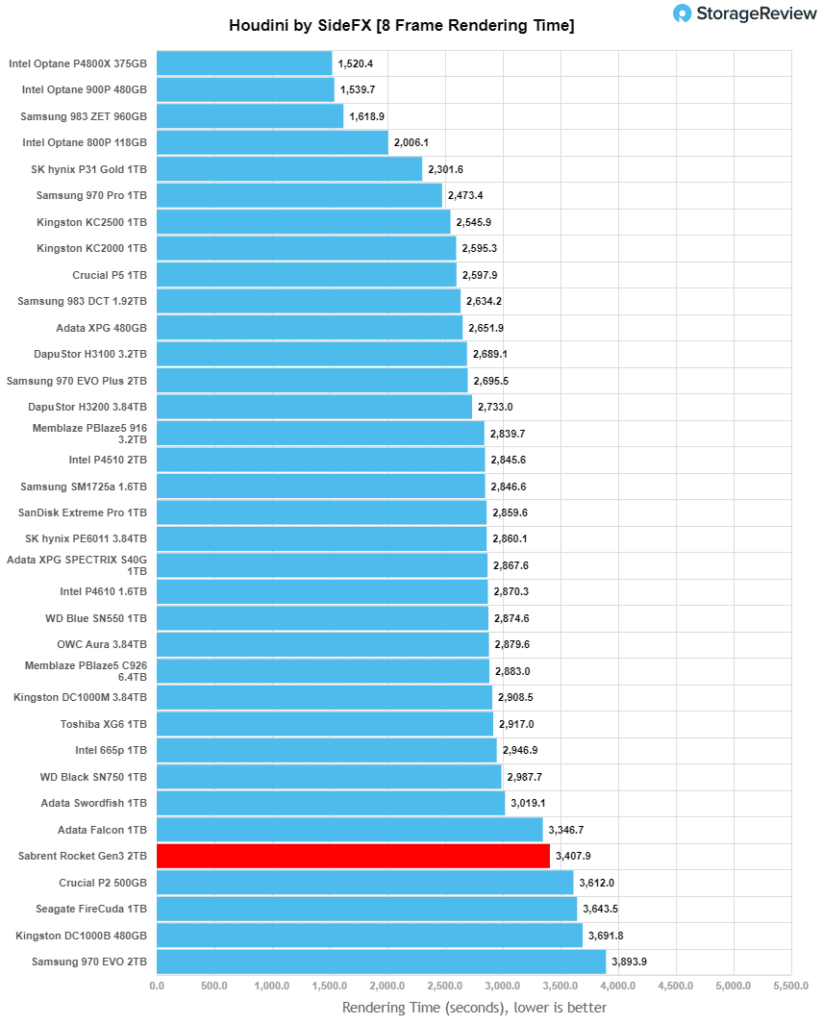
SQL Server Performance
Each SQL Server VM is configured with two vDisks: 100GB volume for boot and a 500GB volume for the database and log files. From a system resource perspective, we configured each VM with 16 vCPUs, 64GB of DRAM, and leveraged the LSI Logic SAS SCSI controller. While our Sysbench workloads tested previously saturated the platform in both storage I/O and capacity, the SQL test is looking for latency performance.
This test uses SQL Server 2014 running on Windows Server 2012 R2 guest VMs and is stressed by Quest’s Benchmark Factory for Databases. StorageReview’s Microsoft SQL Server OLTP testing protocol employs the current draft of the Transaction Processing Performance Council’s Benchmark C (TPC-C), an online transaction-processing benchmark that simulates the activities found in complex application environments. The TPC-C benchmark comes closer than synthetic performance benchmarks to gauging the performance strengths and bottlenecks of storage infrastructure in database environments. Each instance of our SQL Server VM for this review uses a 333GB (1,500 scale) SQL Server database and measures the transactional performance and latency under a load of 15,000 virtual users.
SQL Server Testing Configuration (per VM)
- Windows Server 2012 R2
- Storage Footprint: 600GB allocated, 500GB used
- SQL Server 2014
- Database Size: 1,500 scale
-
- Virtual Client Load: 15,000
- RAM Buffer: 48GB
- Test Length: 3 hours
-
- 2.5 hours preconditioning
- 30 minutes sample period
For our SQL Server transactional benchmark, the Sabrent Rocket posted a solid 3,161 TPS, which was only behind the pair of Samsung 970 EVO Plus drives for third place.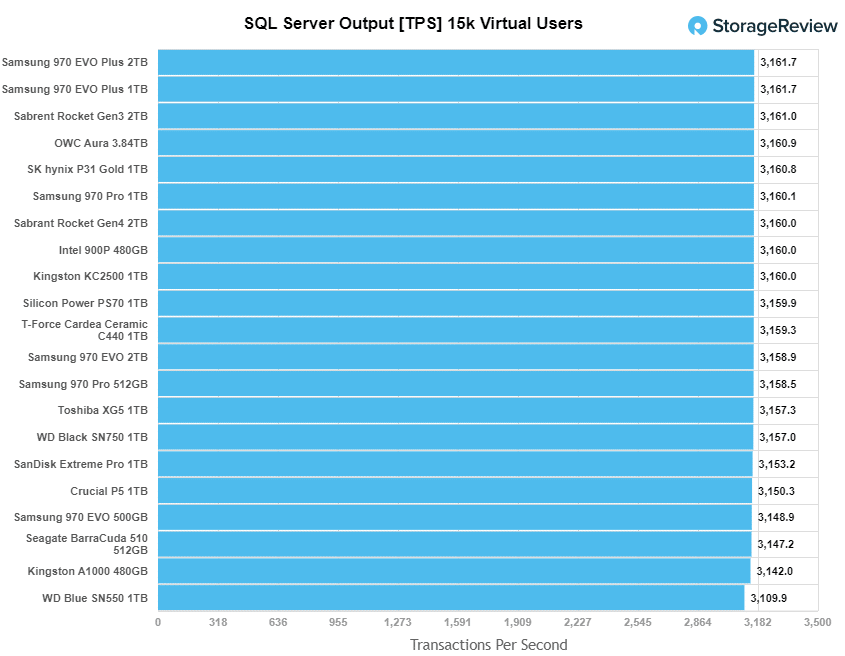
Moving on to latency, the Sabrent Rocket continued its great SQL performance with just 2ms in average latency, again only trailing the Samsung 970 EVO Plus drives.
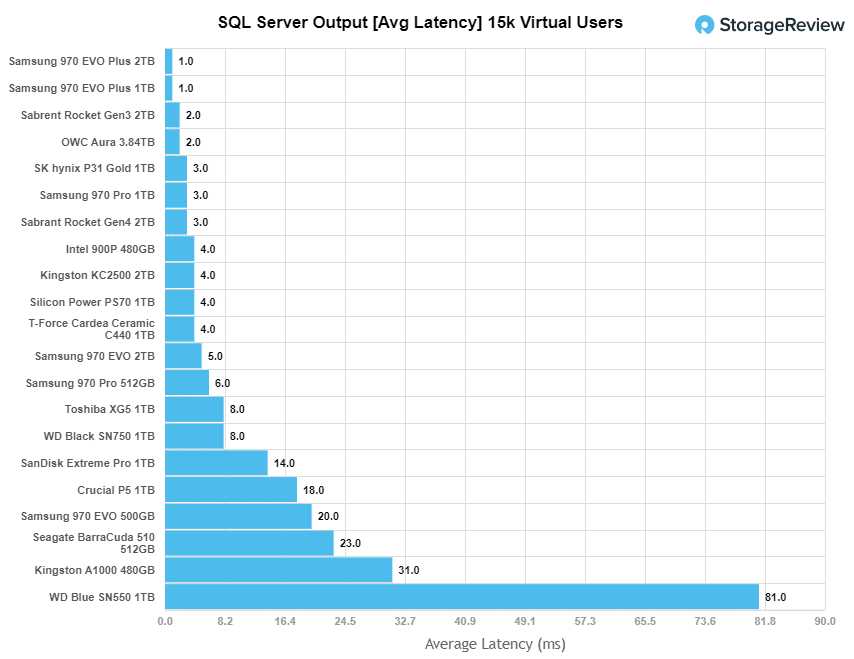
Sabrent ROCKET NVMe SSD VDBench Workload Analysis
When it comes to benchmarking storage devices, application testing is best, and synthetic testing comes in second place. While not a perfect representation of actual workloads, synthetic tests do help to baseline storage devices with a repeatability factor that makes it easy to do apples-to-apples comparison between competing solutions. These workloads offer a range of different testing profiles ranging from “four corners” tests, common database transfer size tests, to trace captures from different VDI environments. All of these tests leverage the common vdBench workload generator, with a scripting engine to automate and capture results over a large compute testing cluster. This allows us to repeat the same workloads across a wide range of storage devices, including flash arrays and individual storage devices. Our testing process for these benchmarks fills the entire drive surface with data, then partitions a drive section equal to 5% of the drive capacity to simulate how the drive might respond to application workloads. This is different than full entropy tests which use 100% of the drive and take them into a steady state. As a result, these figures will reflect higher-sustained write speeds.
Profiles:
- 4K Random Read: 100% Read, 128 threads, 0-120% iorate
- 4K Random Write: 100% Write, 64 threads, 0-120% iorate
- 64K Sequential Read: 100% Read, 16 threads, 0-120% iorate
- 64K Sequential Write: 100% Write, 8 threads, 0-120% iorate
For random 4K read, the Sabrent Rocket showed middle-of-the-pack best-performing drive with a peak score of 407,107 IOPS at a latency of 313.3µs before a slight spike at the very end.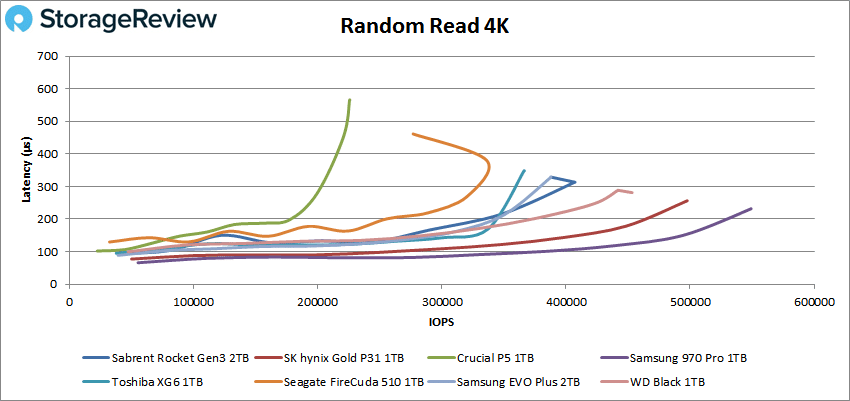
With random 4K write, the Rocket showed weak performance (placing second to last) with a peak score of 117,090 IOPS with a latency of 1091µs.
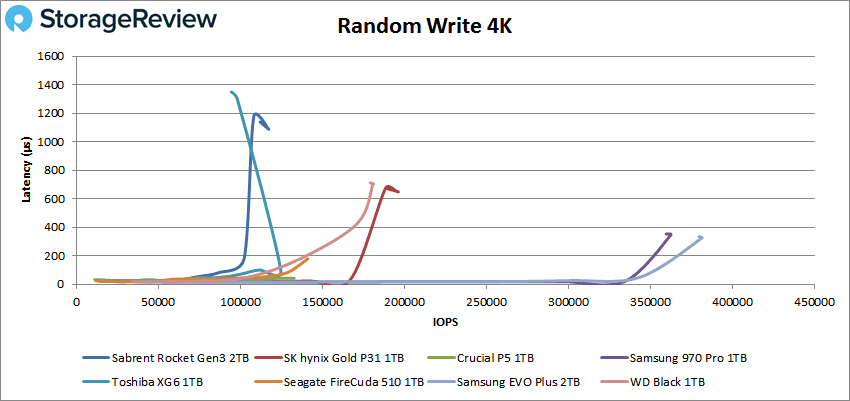
The Rocket performed much better when switching over to sequential read workloads, placing second in 64K read (just behind the SK Hynix Gold) with a peak performance of 3,8911 IOPS or 2.43GB/s at a latency of 410.9µs.
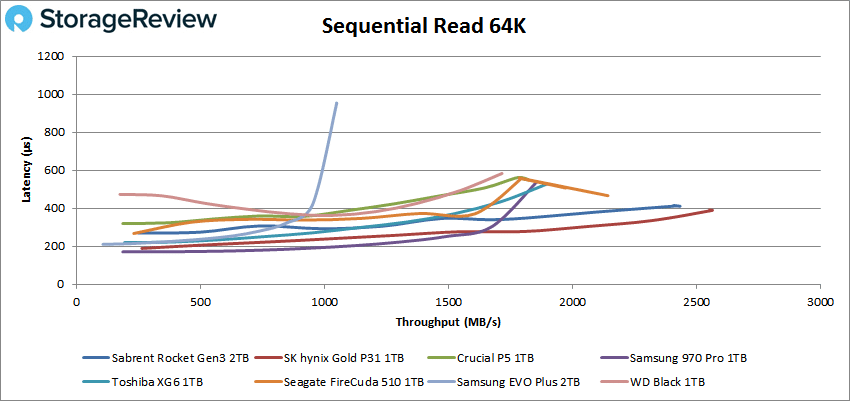
The Sabrent Rocket showed weaker write performance again in the sequential 64K test, peaking at just 11,250 IOPS (or 703MB/s) at a latency of 1,414ms. This placed it near the bottom of the leader board.
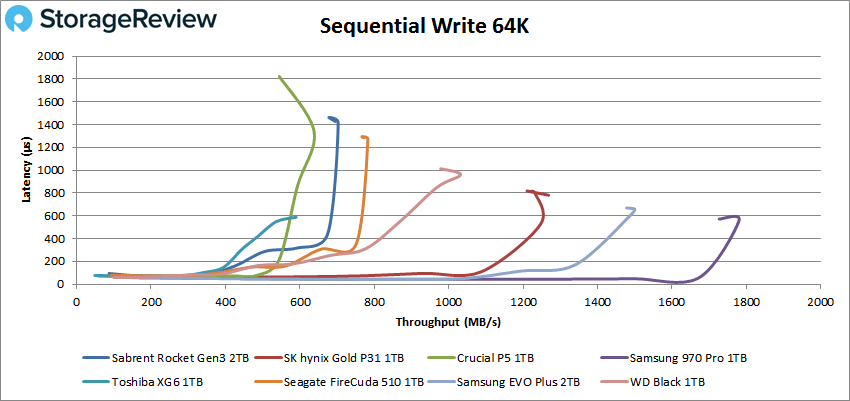
Next, we looked at our VDI benchmarks, which are designed to tax the drives even further. These tests include Boot, Initial Login, and Monday Login. Looking at the Boot test, the Sabrent Rocket PCIe Gen3 showed mid-range performance, peaking at 93,986 IOPS with a latency of 353.5µs before taking hit in performance at the end of the test.
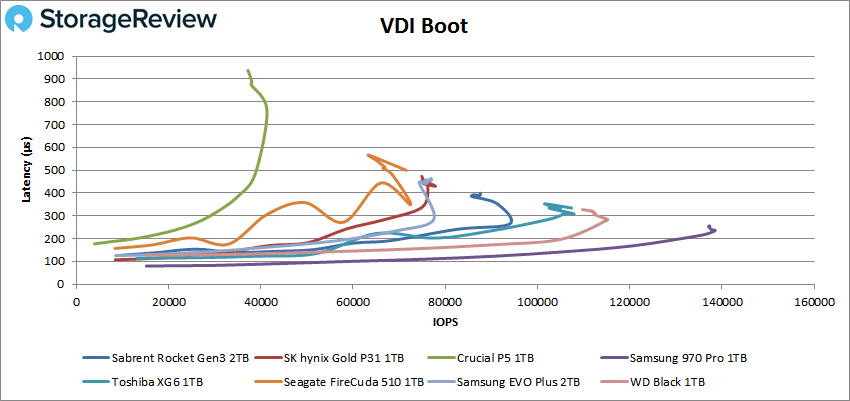
VDI Initial Login, the Rocket showed some serious spikes in latency and IOPS throughout, peaking of 37,009 IOPS with a latency of 807µs before hitting a few last spikes.
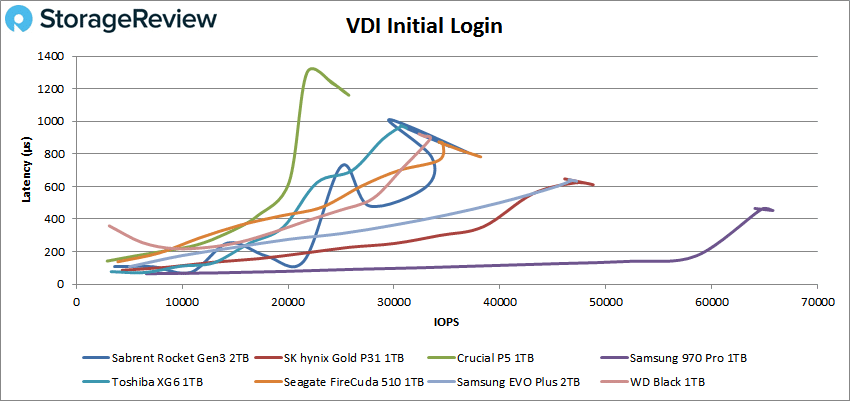
Finally, VDI Monday Login saw the Rocket among the bottom performers with a peak score of 30,523 IOPS and a latency of 522µs before dropping off again
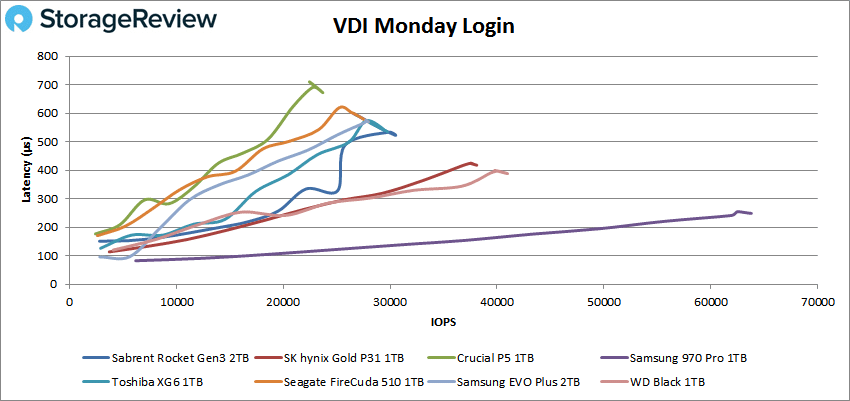
Conclusion
Overall, the Sabrent ROCKET M.2 form factor NVMe SSD is a viable, budget-friendly choice for those looking to upgrade their system. The Rocket is Sabrent’s mid-range model from the company’s consumer storage portfolio (the higher-end model is the Rocket Q4 NVMe PCIe 4.0) and is released to compete alongside other mid-range lines like the Samsung EVO Plus. Featuring 3D NAND and the PCIe Gen3 interface, it comes in a wide range of capacities from 250GB to 4TB, which gives users plenty of flexibility when deciding on the right drive for their needs.
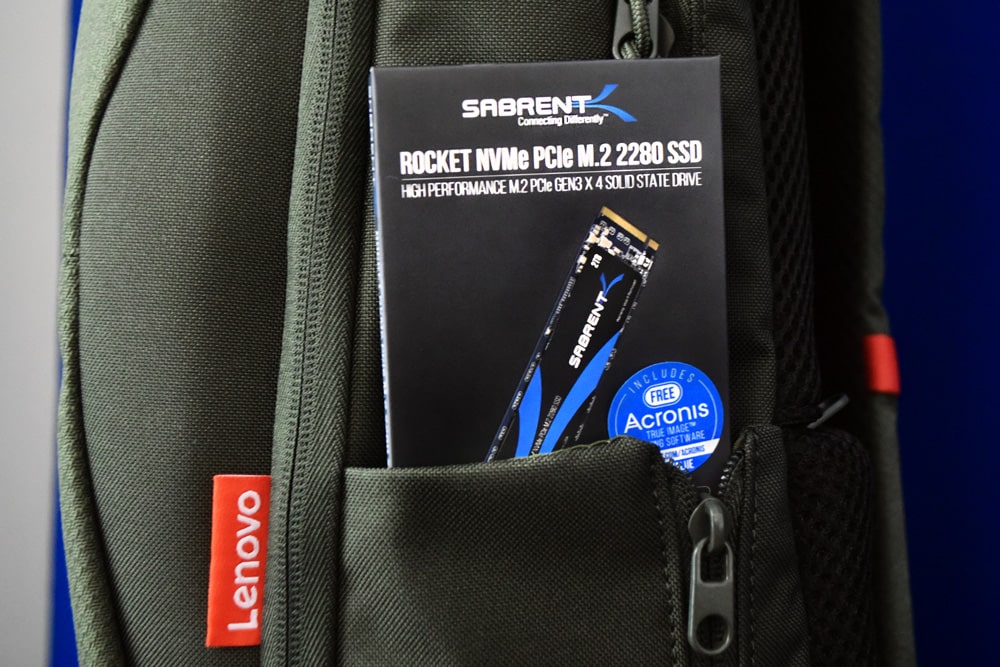 Though it did show great sequential read and SQL performance during our tests, it posted uneven results overall, especially in our 4K and 64K write charts. Highlights include: 3,161 TPS and 2.0ms in SQL Server, 407,107 IOPS in 4K read, 117,090 IOPS in 4K write, 2.43GB/s in 64K read, and 703MB/s in 64K write. In our VDI Clone, we saw 93,986 IOPS in boot, 37,009 IOPS in initial login, and 30,523 IOP in Monday login. It also recorded 3,407.9 seconds in our Houdini test, placing it at the bottom of the leader board.
Though it did show great sequential read and SQL performance during our tests, it posted uneven results overall, especially in our 4K and 64K write charts. Highlights include: 3,161 TPS and 2.0ms in SQL Server, 407,107 IOPS in 4K read, 117,090 IOPS in 4K write, 2.43GB/s in 64K read, and 703MB/s in 64K write. In our VDI Clone, we saw 93,986 IOPS in boot, 37,009 IOPS in initial login, and 30,523 IOP in Monday login. It also recorded 3,407.9 seconds in our Houdini test, placing it at the bottom of the leader board.
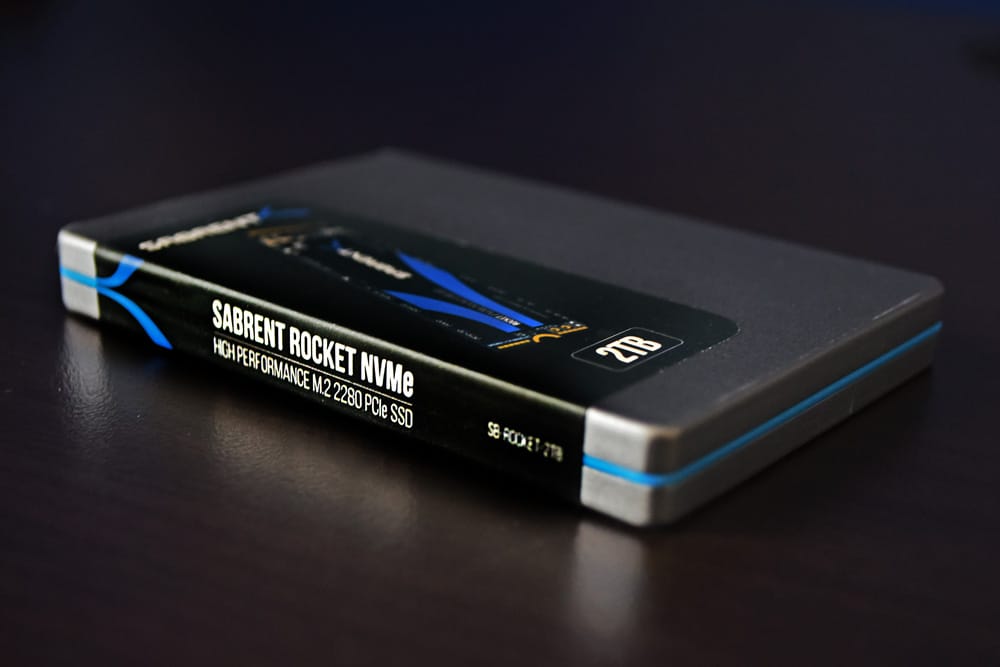 Though its performance was a bit disappointing in some areas, its price tag is certainly not. The 1TB and 2TB capacities currently go for $150 and $280, respectively, and if you’re just looking for a small capacity drive just for your operating system, it only costs 50 bucks for the 256GB model. In comparison, the Samsung EVO Plus retails around $190 (1TB) and $430 (2TB), while the Crucial P5 currently goes for roughly $180 (1TB) and $400 (2TB), both of which the Rocket outperformed in sequential reads (though as we mentioned above, it did fall behind in most other categories). That said, if you’re looking for an inexpensive NVMe drive, and you’re not too worried getting the best performance possible from a consumer drive, the Sabrent Rocket Gen3 PCIe NVMe SSD is definitely a solid option.
Though its performance was a bit disappointing in some areas, its price tag is certainly not. The 1TB and 2TB capacities currently go for $150 and $280, respectively, and if you’re just looking for a small capacity drive just for your operating system, it only costs 50 bucks for the 256GB model. In comparison, the Samsung EVO Plus retails around $190 (1TB) and $430 (2TB), while the Crucial P5 currently goes for roughly $180 (1TB) and $400 (2TB), both of which the Rocket outperformed in sequential reads (though as we mentioned above, it did fall behind in most other categories). That said, if you’re looking for an inexpensive NVMe drive, and you’re not too worried getting the best performance possible from a consumer drive, the Sabrent Rocket Gen3 PCIe NVMe SSD is definitely a solid option.
Sabrent Rocket PCIe Gen3 on Amazon
Engage with StorageReview
Newsletter | YouTube | Podcast iTunes/Spotify | Instagram | Twitter | Facebook | RSS Feed
